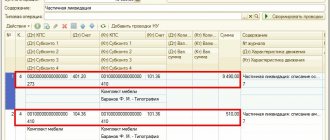Where to submit and when?
First of all, the annual balance must be submitted to the Federal Tax Service.
Suppliers or founders may also request a balance sheet to assess the financial position of the company.
The deadline for submitting the balance sheet for 2021 is March 31, 2020 inclusive.
Previously, one copy of the balance sheet as part of the financial statements had to be sent to the territorial statistics body (Article 18 of the Federal Law of December 6, 2011 No. 402-FZ). This obligation has been canceled for reporting for 2019. The exception is organizations whose reporting contains state secrets, and those obliged by the Government of the Russian Federation.
All organizations are required to submit reports for 2021 electronically through an EDI operator. Small businesses could also submit reports for 2021 on paper, but this is now prohibited.
Balance in accounting
Now that it has become clear what a balance is and how to calculate it for simple life situations, let’s move on to more global calculations. Let's start with accounting for transactions within the enterprise. In accounting, a balance is the balance of an active or passive accounting account.
Such balances at the end of the quarter or year are transferred to the balance sheet - the main report on the financial and economic activities of the enterprise.
Accounting accounts are divided into active and passive. Active are accounts that reflect the movement of assets. Let me remind you that assets include:
- fixed assets;
- intangible assets;
- supplies (materials, goods, etc.);
- cash;
- accounts receivable.
Passive accounts take into account the sources of funds:
- authorized capital;
- retained earnings;
- accounts payable.
For active accounts, the balance must be in debit. This means that the debit (receipt) must exceed the credit (expense). For example, the inventory of goods in a warehouse or the balance of money in the cash register cannot be expressed as a negative value. Thus, for such accounts the balance can only be debit (reflected on the left side of the accounting register) or zero.
In passive accounts, on the contrary, the credit must be greater than the debit, and the balance is located on the right side of the register. For example, a bank loan debt is reflected in a liability account. If the debit on such an account exceeds the credit, this means that you overpaid, that is, you gave the bank an amount greater than your debt. In this situation, the balance at the end of the period will be located on the right side of the register and take on a negative value. A negative balance is always highlighted in red in the accounting program.
A red balance in accounting means that an error was made somewhere. If an accountant creates a statement of accounts and sees, for example, that the cash balance is negative and highlighted in red, it means that some operation was missed or reflected incorrectly.
There are also active-passive accounts in which the balance can be calculated both as a debit and as a credit. For example, if the balance for settlements with customers is debit, this means that the buyer owes us. A loan balance arises in cases where the buyer has transferred an advance payment for which shipment has not yet been made.
How to draw up a balance sheet
Assets and liabilities are components of the balance sheet.
The asset includes two sections: current assets (debtors' debt, money in accounts, etc.) and non-current assets (intangible assets, fixed assets, deferred tax assets, etc.).
The passive consists of three sections:
- Capital and reserves.
- Short-term liabilities.
- Long term duties.
The asset of the balance sheet informs about all the property of the company, and the liability tells about the sources of receipt of this property. Equality must be observed: Active = Passive.
The balance sheet contains information at the end of the year. It also provides information on all indicators at the end of the previous two years. Thus, in the balance sheet for 2021, accountants will also indicate data for 2021 and 2021.
All balance sheet indicators are combined into articles. Each balance line has its own code. Small businesses can draw up a brief balance sheet, but other companies provide a detailed breakdown of all items. The organization itself determines how much detail to disclose information in the balance sheet, based on the level of materiality of a particular indicator (note No. 2 to the balance sheet, specified in Order of the Ministry of Finance of Russia dated July 2, 2010 No. 66n). Information about materiality levels is usually specified in the accounting policies.
View balance line codes
PBU 4/99 discloses information about what indicators need to be included in the balance sheet.
Reporting to the Federal Tax Service on time and without errors! We are giving access for 3 months to Kontur.Ektern!
How to determine the balance?
Let's say you open a bank account as an individual. The opening balance of the account will be zero. A few days later, you received a salary in the amount of 75,000 rubles. ($1,000 or 29,000 UAH), and then you made some expenses in the amount of 22,500 RUB. ($300 or 8,700 UAH). There were no more movements on the account in a month. Thus, the balance at the end of the period in your account will be 52,500 rubles. ($700 or 20,300 UAH).
Another example. At the beginning of the month, your friend owed you 37,500 rubles. ($500 or 14,500 UAH). Within a month, he partially repaid his debt by transferring you 22,500 rubles. ($300 or 8,700 UAH). At the end of the month, the settlement balance amounted to 15,000 rubles. ($200 or 5,800 UAH) in your favor. When the balance of a debt is calculated, the balance is always in favor of the one to whom the creditor owes.
How to calculate the balance? To do this you need to perform two steps:
- To the initial account balance, add the amounts for transactions that increase this balance. This also applies to debt obligations. Let's say you owed Petya 7,500 rubles. ($100 or 2,900 UAH) and took another 15,000 rubles from Vasya. ($200 or 5,800 UAH). Thus, your current accounts payable is RUB 22,500. ($300 or 8,700 UAH).
- Next, you need to subtract the amounts for reverse operations from this value. Let's assume that this month you returned Petya 3,750 rubles. ($50 or 1,450 UAH), and the credit balance will be 18,750 rubles. ($250 or 7,250 UAH) (300-50).
We draw up a balance at the end of the current month
Subject and method of accounting Read more: Types of business transactions and their impact on the balance sheet
5. We draw up a balance sheet at the end of the current month.
| ASSETS | PASSIVE | ||
| The content of the article | Amount, rub. | The content of the article | Amount, rub. |
| Fixed assets – 01 | 74000 | Authorized capital – 80 | 101700 |
| Materials – 10 | 3000 | Settlements on short-term loans – 66 | 30000 |
| Main production – 20 | 12000 | Settlements with suppliers and contractors – 60 | |
| Cash desk – 50 | 1000 | Calculations for taxes and fees – 68 | 3000 |
| Current accounts – 51 | 46000 | 1300 | |
| Balance | 136000 | Balance | 136000 |
2.2 Reflection in the balance of active-passive accounts
Balances on active-passive accounts in the balance sheet are reflected as follows: the assets of the balance sheet reflect receivables, i.e. debit balances on active-passive accounts, and in the liabilities side of the balance sheet - accounts payable, i.e. credit balances. We can formulate the following rule for reflecting accounting accounts in the balance sheet.
| ASSETS | PASSIVE |
| Debit balances on active accounts | Credit balances on passive accounts |
| Accounts receivable on active-passive accounts | Accounts payable on active-passive accounts |
Let's look at an example of how account balances are reflected in the balance sheet.
Example. Reflection of account balances in the balance sheet.
Exercise. Based on the balances on these accounts, draw up a balance at the beginning of the month.
To solve the problem, we will indicate on the debit or credit of which account the balance amounts will be reflected.
| Household supplies | Amount, rub. | Account debit or credit |
| 1. Equipment | 96000 | D01 |
| 2. Buyers' debt | 6700 | D62 |
| 3. Debt to suppliers | 3000 | K 60 |
| 4. Construction materials | 4500 | D10 |
| 5. Tax debt to the budget | 8400 | K 68 |
| 6. Arrears in wages | 14000 | K 70 |
| 7. Motor transport | 68000 | D01 |
| 8. Spare parts | 16000 | D10 |
| 9. Cash | 2000 | D50 |
| 10. Reserve capital | 18000 | K 82 |
| 1 1. Current account | 35000 | D51 |
| 12. Debt to an accountable person | 1300 | K 71 |
| 13. Accounts receivable | 3400 | D76 |
| 14. Debt of the founders | 6000 | D75 |
| 15. Authorized capital | 192900 | K 80 |
Keep in mind that on the balance sheet, each account is reflected in the final estimate. For example, account 10 contains construction materials worth 4,500 rubles. and spare parts in the amount of 16,000 rubles, therefore, the total amount on account 10 will be 20,500 rubles. Similarly, on account 01, all funds will be credited in the amount of 164,000 rubles, which consists of the cost of equipment and vehicles.
| ASSETS | PASSIVE | ||
| The content of the article | Amount, rub. | The content of the article | Amount, rub. |
| Fixed assets – 01 | 164000 | Authorized capital – 80 | 192900 |
| Materials – 10 | 20500 | Reserve capital – 82 | 18000 |
| Settlements with buyers and customers – 62 | 6700 | Settlements with suppliers and contractors – 60 | 3000 |
| Settlements with founders – 75 | 6000 | Settlements with personnel for wages – 70 | 14000 |
| Settlements with debtors and creditors – 76 | 3400 | Calculations for taxes and fees – 68 | 8400 |
| Cash desk – 50 | 2000 | Settlements with accountable persons – 71 | 1300 |
| Current accounts – 5 1 | 35000 | ||
| Balance | 237600 | Balance | 237600 |
Subject and method of accounting Read more: Types of business transactions and their impact on the balance sheet
Information about the work “Subject of accounting research”
Section: Accounting and Auditing Number of characters with spaces: 54744 Number of tables: 25 Number of images: 7
Similar works
Accounting and Auditing
158788
5
0
... is the lack of connection with accounting programs. As a result, there is a need to link legislative acts and accounting directly to the chief accountant, which sometimes causes difficulties. Chapter 3. AUDIT OF THE FINANCIAL RESULTS OF AN ENTERPRISE AND THE USE OF PROFIT 3.1 Methodology for auditing the financial results of an enterprise The formation of market relations ...
Accounting methods: documentation, inventory, accounts and double entry
41413
4
0
... ; All this predetermines the need for a deep understanding and understanding of the system of techniques, methods that form the basis and content of the accounting method. The components of the accounting method are: - documentation and inventory; — assessment and calculation; - accounts and double entry; — balance sheet summary and reporting[3]. 1.2 Documents, their role and significance in accounting. ...
Fundamental Accounting Principles
93972
1
6
... management. In addition, such information is available to outsiders through press conferences or the media. 2. FUNDAMENTAL PRINCIPLES OF ORGANIZING ACCOUNTING 2.1 General principles of organizing accounting The efficiency of business entities largely depends on the correct organization of accounting. General principles for organizing accounting...
Accounting analysis and audit of fixed assets using the example of Tekhpromservice LLC
198524
18
7
...production output and capital productivity through more complete use of fixed assets. 3.4 Ways to improve the efficiency of using fixed assets in TekhPromServis LLC As the study showed, accounting of fixed assets at the enterprise is carried out in accordance with the requirements established by the Accounting Regulations “Accounting for Fixed Assets” PBU 6/01. Positive...







